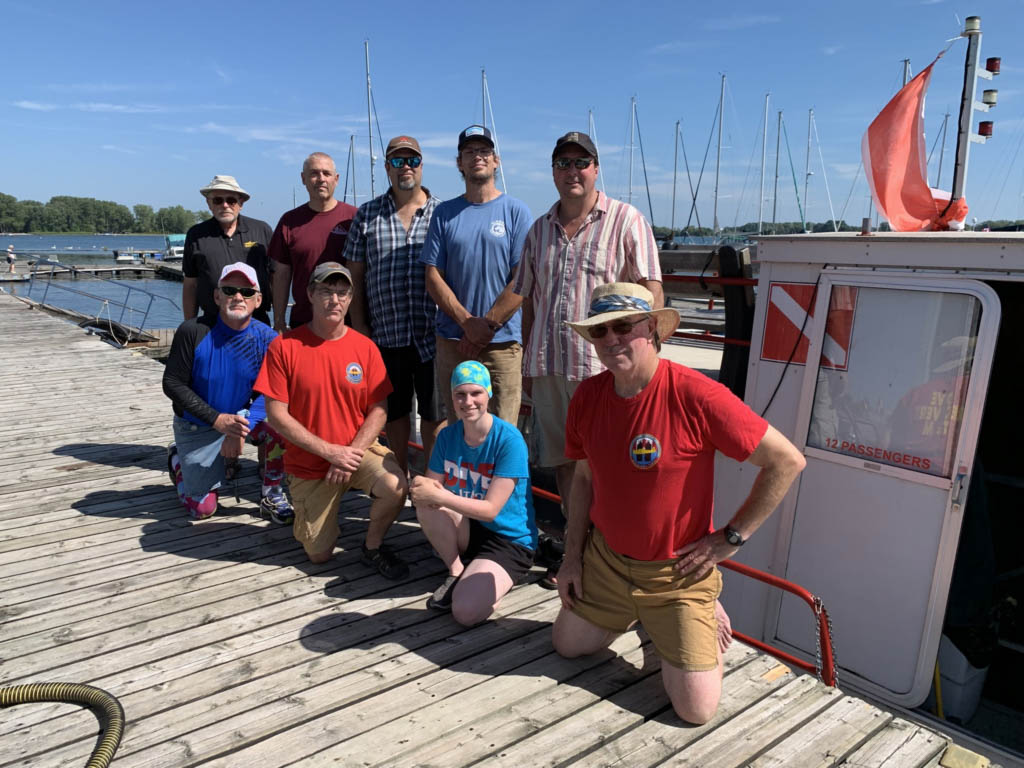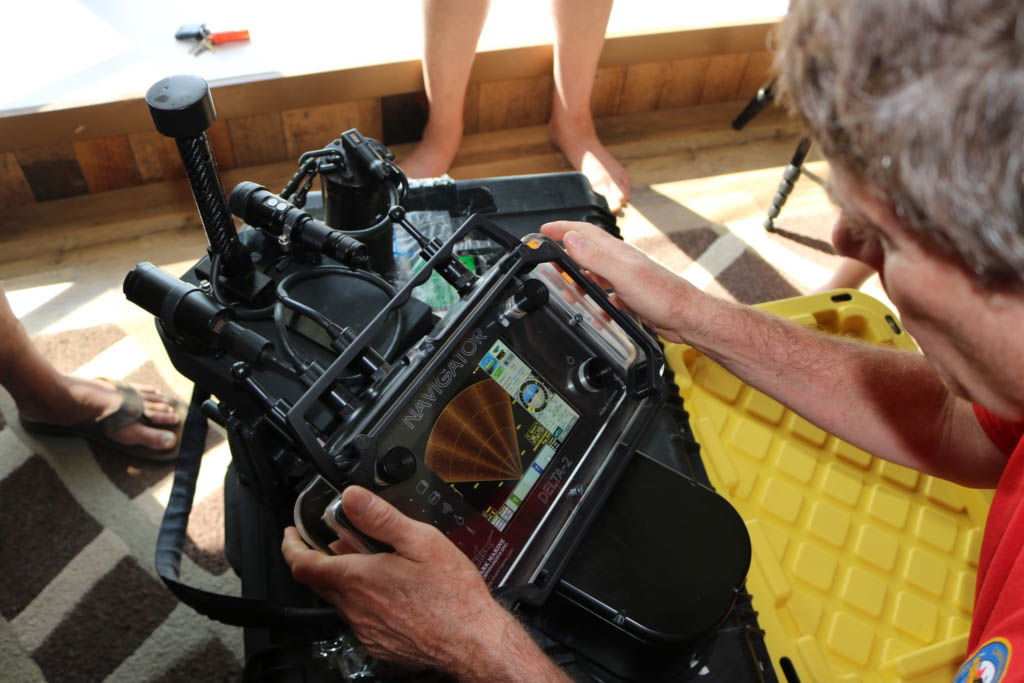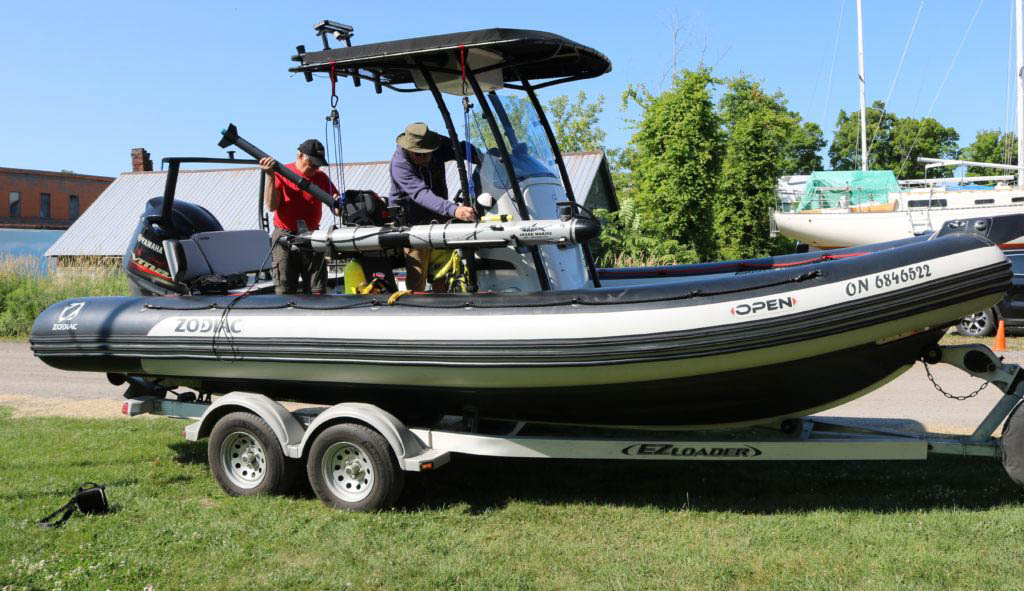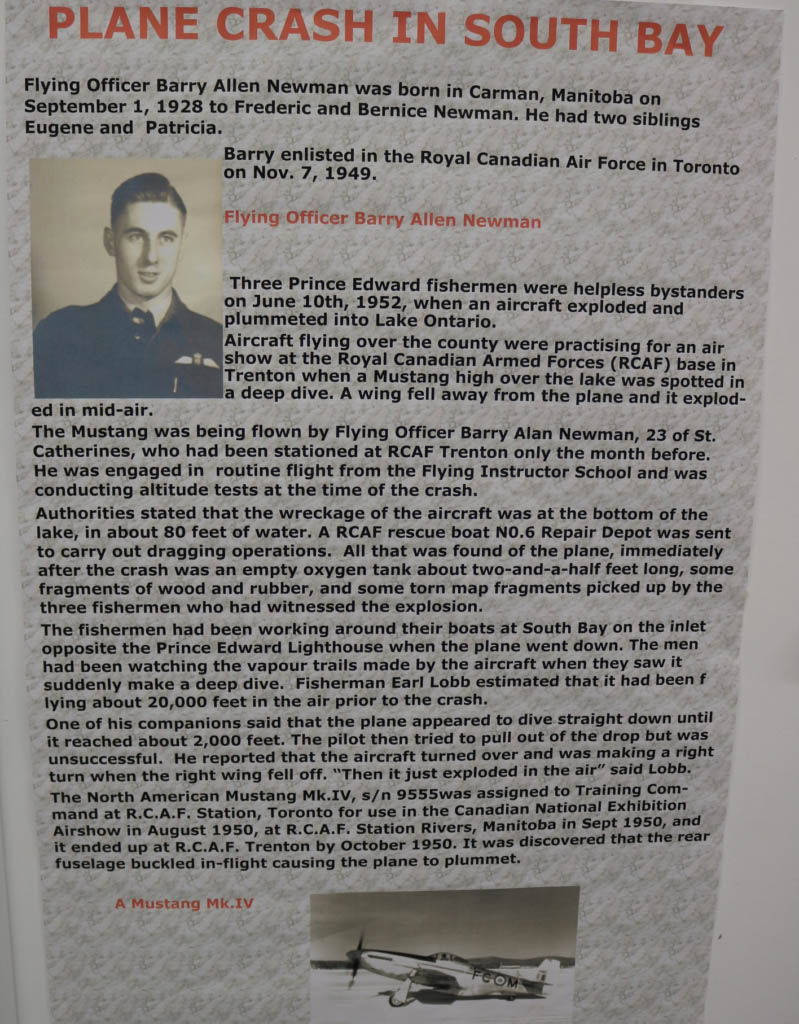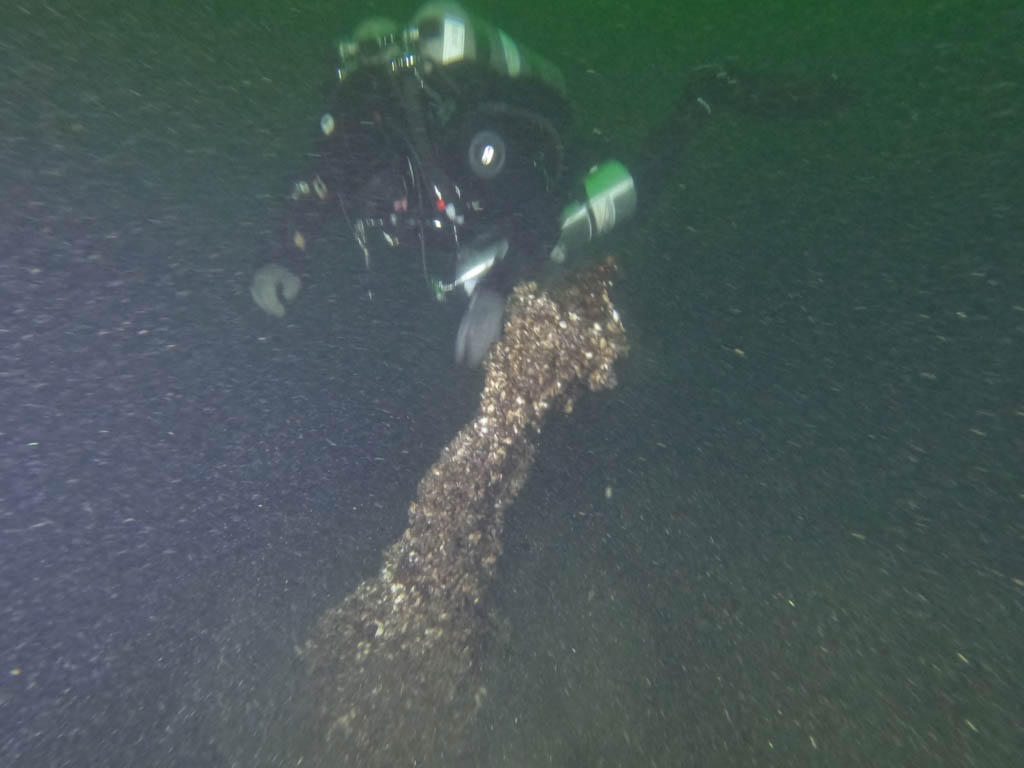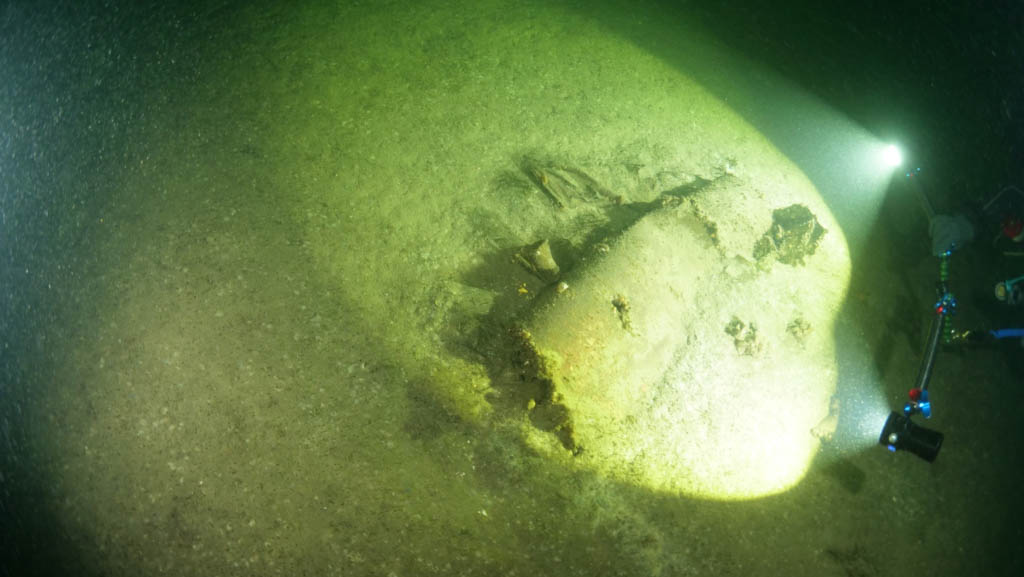Follow Up From The Scuba News Canada’s Article from Mike McAllister
In the deep and dark waters at the bottom of Lake Ontario off Prince Edward County Ontario, lies a mystery.
In 2020 & 2022 after years of research, and a licence to Carry Out Marine Archaeological Fieldwork obtained by Derek Niles of Orange Force Marine, from the Government of Ontario, several sonar surveys were conducted by the Canadian Harvard Aircraft Recovery Team using the advanced underwater equipment of Shark Marine Technologies Inc. with the aim of finding a lost WWII era fighter aircraft and locating the final resting place of it’s pilot.
Interesting objects were seen on the bottom in the sonar data obtained from an Autonomous Underwater Vehicle, called an Iver, this AUV which resembles a small torpedo, also towed a proton magnetometer in it’s programmed search pattern. The sonar unit emits sound pulses which return to the unit and are then visually represented. This works because signals bouncing off a near object take less time to return than signals from the lakebed do, thus allowing the software in the sonar unit to form an image using the time difference that it takes the signal to return. The magnetometer shows ferrous metal anomalies, which may be concealed from sight under the lake bed.
The AUV after being launched from the boat conducts a grid search pattern by taking a GPS reading at the surface and descending to search depth where it proceeds in a straight line gathering sonar data, then ascending to the surface to get another GPS reading before it returns to depth to run the next line of the grid. The operator can send signals by sound from a transmitter on the boat to tell the AUV to change it’s depth or to run a different program.
Flying Officer Barry Allen Newman was 23 years old on June 10 1952, when he climbed into the cockpit of P-51 Mustang #9555 at the Royal Canadian Airforce’s Unit No.1 Flying Training School, Trenton Ontario, to perform high altitude flight tests. Newman had been born in Carman Manitoba, and had moved to Grimsby Ontario with his parents Frederic and Bernice. The aircraft that Newman was flying that day, was a P-51 D Mustang built by North American Aviation. Powered by a Rolls Royce designed Merlin V12 engine built in Detroit by the Packard Motor Company, and carrying three Browning 50 caliber Machine guns in each wing, these fighters were used by Allied forces in both air combat and ground attack roles in WWII.
The flight test instructions for that day indicated that the aircraft was to be flown to 34,000 ft. It was equipped with an oxygen supply system for the pilot, as oxygen is required anywhere above 10,000 ft to prevent a pilot from losing consciousness due to hypoxia (oxygen starvation). Although the system had been checked and found to be working by Newman and a member of the ground crew, faults had previously been discovered in the oxygen systems of other P-51 Mustangs.
The plane was first noticed by onlookers on the ground when it began to leave condensation trails while turning at somewhere above 24,000 ft. In the words of witness Mel McIntosh ::
“While I was watching he started a circle to the left and very nearly completed it when he made a very sharp little turn to the left. At this point he started to come down. As I continued to watch the vapour trails I did not observe the aircraft for a short time. When I next saw it, it was still very high and was spinning or spiraling down at a very high speed and increasing. There was a terrific noise increasing to a high pitched whine as he came down. He continued like this until I estimate two thousand feet when the plane partially leveled off. The wing or part of it came off and then I heard a heavy explosion. At this time the aircraft engine made a much louder noise. The heaviest part of the aircraft disappeared behind the trees followed shortly by the wing.” (part of witness sworn statement)
Within days of the accident, hard hat divers had recovered most of the port wing, the propeller and some other small parts of the plane, but the engine, cockpit and fuselage along with the body of Flying Officer Newman had not been found.
Following the granting of a search licence to dive on the targets seen on sonar, from the Ontario Ministry of Heritage, a diving search weekend was planned.
(Divers are not allowed to touch anything and the Government must be kept fully informed or consequences are severe)
Paul Darnbrough arranged with Helen Cooper of Dive Brockville, to charter her Dive Boat “AMG” and also was able to procure accommodations for the team at a lakeside cottage near the launch point that had actually just closed for the season at that time.
In September 2022 ,on the morning of the first dives, 9 team members assembled in the main room of the cottage to be trained by Shark Marine CEO and diver Jim Garrington on how to operate a search device called a Navigator.
Designed and built for Military use by Shark Marine Technologies Inc. of St. Catherines, Ontario, the Navigator, in appearance and operational ability resembles something that could have been seen in science fiction.
The Navigator, a diver held sonar unit, which appears somewhat like a television news camera, is able to detect objects underwater in zero visibility, whether stationary or moving and show them to the diver in real time on its screen. The screen can be changed from the sonar display to a chart showing your location relative to the target and zoomed in and out.
After a training session on the Navigator the team set out with Captain Helen Cooper on the boat AMG out of Waupoos Marina travelling some distance out into the Lake where the field of unknown objects lay. (actual location is kept confidential)
On the first day, after dropping a shot line (a surface float attached to weights) as close to the first target as possible, the first team of three divers Paul Darnbrough, Paul Chapple and myself entered the water, following the shot line down, Paul Chapple operating the Navigator and the other two following and searching with dive lights, ready to take stills and video of what may be found. With sediment in the water and at depths of approximately 100 ft (30 meters) these dives were like night dives. We didn’t find anything.The second team of divers geared up while the first team was in the water, and would enter the water at the next search location, while the third team geared up and the first team waited out their surface interval. All hands were prepared to render any assistance required to those entering and leaving the water.
As there was no mooring line, the dive boat would not anchor, but would cut power after arriving at the target and drift. Upon their return the divers all made free ascents. Several pairs of eyes were on the diver’s bubbles, as the boat would drift away from the shotline float and the searching divers were not always near it. Knowing that at the helm was an expert Dive Boat Captain gave the divers full confidence.
Each team made two dives on each of two successive days, some members did three dives. Durrell and Kayla Martin had to leave after the first day and Elizabeth Colp Larson joined the team for a few dives on Saturday.
Interesting objects were found at several locations and although mostly covered in zebra mussels it was apparent that these things we were seeing were man made.
One of the objects found on the second day, by divers Corey Phillips, Steve Mueller,and Craig Smith, although partly buried in the sediment, appeared to the team upon viewing the camera footage, to possibly be a wing.
Also on the second day Paul Chapple and I entered the water following Jim Garrington who was operating the Navigator and travelling about 5 feet off the bottom. We saw Jim stop and turn, his light then illuminating a strange looking object which suddenly seemed to appear right in front of me (it was almost as dark as a moonless night down there) It was covered in zebra mussels, appeared cone shaped, narrowing at the top and was about 5 feet high We then circled the object and I was able to see into a small spot where there were no zebra mussels and inside were some vertical metal strips about 1/8″ thick.
Upon returning to the boat we informed the team of our find and Steve Mueller, Corey Phillips and Paul Darnbrough went down the shot line, Corey bringing his two camera rig and Paul Darnbrough helping to illuminate the object.
Some footage was reviewed on the way back to harbour, the team very pleased with having found man made objects right in the middle of the target area. At a later ZOOM meeting 5 days after the dive when the camera footage and stills were reviewed by more members of the team, CHAA member Mark McCrae pointed out that the object which could be a wing, appeared to have a gun camera port, in the right spot where one would be on a P-51-D Mustang.
The next step will be to secure permission from the ministry to recover some parts of what is believed to be Flying Officer Newman’s Aircraft for positive identification, only then can this case be closed. CHAA-Recovery has obtained permission in the past to bring to the surface, parts of a WW II Harvard aircraft which had crashed in Lake Erie. As this is believed to be the debris field of a mass produced metal aircraft and not a rare wooden shipwreck we believe that this should be done.
In addition CHAA – Recovery has initiated a project to locate the wreck of a Curtis P-40 fighter flown by RCAF Squadron Leader Jacques Chevrier, which was lost on patrol on July 6 1942 near the mouth of the St.Lawrence River while while hunting the Submarine U-132 near Cap Chat, which had just sunk three freighters earlier that day. It is thought that Chevrier’s aircraft ran out of fuel but some have speculated that it may have been hit by gunfire from the U-Boat. Although the general location is known, neither the aircraft or pilot’s remains have ever been found. Jacques Chevrier was the first Canadian to lose his life on duty on Canadian territory during WWII, during what later became known as the Battle of the St. Lawrence.
With help from the public, this story will continue……
We would like to give special recognition to:
Jim Garrington of Shark Marine Technologies Inc. who along with other CHAA-Recovery Members, carried out the earlier sonar surveys and trained the team on the use of his equipment.
Helen Cooper of Dive Brockville (Abucs) Dive Boat Captain who put the team over the targets.
Paul Darnbrough who organized the dive weekend and arranged with Helen for the use of her boat, brought in 3 divers from Save Ontario Shipwrecks and also found accomodations for the team.
Derek Niles of Orange Force Marine who obtained the licence which permitted the search
Bil Thuma of GeoTech who spearheaded Project 9555 and set up the funding effort.
Walther Irie, Canadian Harvard Aircraft Association Dive Recovery Team Leader
Divers on the Search Weekend:
Jim Garrington, Paul Darnbrough, Paul Chapple, Durrell Martin, Kayla Martin, Corey Phillips, Craig Smith, Steve Mueller, Mike McAllister and Elizabeth Colp Larson.
Many thanks must also go to the CHAA-Recovery Team members who do many hours of research for these projects and also raise funds through various methods to keep these efforts going. (The list of names would be too long) and finally special recognition is due to Ken “The Professor” MacMillan of McQuest Marine, Terry Kovacevic of London Scuba Centre and Dean McConnachie of the Dive Academy for their long time support of CHAA’s efforts to raise awareness of Canadian History.
More info here: bit.ly/BarryNewman
Support
The Scuba News Canada thaanks Mike McAllister for the contribution of this article.
Follow Mike’s Dive Adventures on Facebook.



